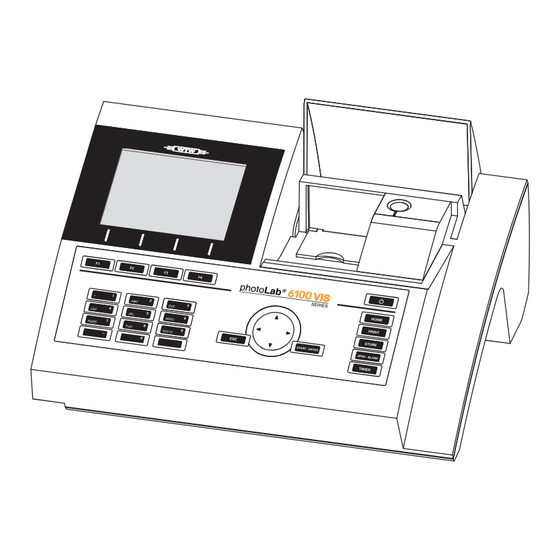
wtw photoLab 6100 VIS Manual
Spectrophotometer
Hide thumbs
Also See for photoLab 6100 VIS:
- Operating manual (48 pages) ,
- Operating manual (206 pages)
Subscribe to Our Youtube Channel
Summary of Contents for wtw photoLab 6100 VIS
- Page 1 Functional description ® photoLab 6100 VIS Spectrophotometer (identical to spectroFlex 6100) ba75847e01 08/2009...
- Page 2 The latest version of the present operating manual is available on the Internet under http://www.WTW.com. © Copyright Weilheim 2009, WTW GmbH Reprinting - even as excerpts - is only allowed with the explicit written authorization of WTW GmbH. Printed in Germany.
-
Page 3: Table Of Contents
® photoLab 6100 VIS Contents ® photoLab 6100 VIS - Contents Overview ........7 Overview of the instrument . - Page 4 ® Contents photoLab 6100 VIS Zero adjustment ....... 37 Measuring in Concentration mode ....41 4.5.1 Measuring cell tests with barcode .
- Page 5 ® photoLab 6100 VIS Contents 4.10.2 Analysis timer ......100 4.11 Memory ........102 4.11.1 Overview .
- Page 6 ® Contents photoLab 6100 VIS Maintenance and cleaning ..... 151 Replacing the lamp ......151 Exchanging the buffer batteries .
-
Page 7: Overview
® photoLab 6100 VIS Overview Overview Overview of the instrument Front of the instrument 1 Display 2 Keypad 3 Shaft for rectangular cells 4 Turn-up lid 5 Shaft for round cells 6 Cell shaft cover Fig. 1-1 Front of the instrument with operating elements Socket field on the rear panel 7 Connection for power pack... -
Page 8: Keypad
® Overview photoLab 6100 VIS Keypad Overview 1 Function keys F1 to F4 (function menu-depending) 2 Alphanumeric keypad 3 Keys with dedicated function Fig. 1-3 Keypad Key functions The keys on the right side of the keypad have the following functions: Designation Functions <ON/OFF>... - Page 9 ® photoLab 6100 VIS Overview Designation Functions <TIMER> – Opens the menu, Timer. <ESC> – Cancels the running action. Entries that have not yet been accepted are discarded. – Switches to the next higher menu level. <START·ENTER> – Starts an action (e.g. measurement) –...
-
Page 10: Display
® Overview photoLab 6100 VIS Display Display elements Concentration 04/16/07 9:52 1.92 mg/l 18: 14752 10 mm 0.05 - 3.00 mg/l Setup Citation form Unit Method list 1 Status line (current state, date and time) 2 Display range for menus and measurement results 3 Function keys menu Bild 1-4 Display... -
Page 11: Safety Instructions
® photoLab 6100 VIS Safety instructions Safety instructions This operating manual contains basic instructions that you must follow during the commissioning, operation and maintenance of the photometer. Consequently, all responsible personnel must read this operating manual carefully before working with the meter. Keep this operating manual in the vicinity of the meter. -
Page 12: Authorized Use
® Safety instructions photoLab 6100 VIS Authorized use The authorized use of the photometer consists exclusively of the carrying out of photometric measurements according to this operating manual. Follow the technical specifications of the cells in chapter 7 T . Any other ECHNICAL DATA use is considered to be unauthorized. -
Page 13: Handling Of Hazardous Substances
6100 VIS Safety instructions Handling of hazardous substances When developing test sets, WTW carefully sees that the tests can be carried out as safely as possible. Some hazards by dangerous substances, however, cannot always be avoided. Warning Improper handling of certain reagents can cause damage to your health. - Page 14 ® Safety instructions photoLab 6100 VIS ba75847e01 08/2009...
-
Page 15: Commissioning
® photoLab 6100 VIS Commissioning Commissioning Scope of delivery ® Spectrophotometer photoLab 6100 VIS Power pack connection cable Buffer batteries 4 x AA alkaline manganese (Mignon) Zero cell (16 mm, round) Short instructions CD-ROM with – Detailed operating manual – Analysis instructions –... -
Page 16: Inserting The Buffer Batteries
® Commissioning photoLab 6100 VIS 3.2.1 Inserting the buffer batteries The buffer batteries supply the integrated clock while the photometer is switched off. Four alkaline manganese batteries (type AA or Mignon) separately included in the scope of delivery are used as the buffer batteries. Insert the batteries as follows: 1 Turn the photometer upside down and place it on a soft surface. -
Page 17: Connecting The Power Supply
® photoLab 6100 VIS Commissioning 3.2.2 Connecting the power supply The power is supplied with the aid of the enclosed plug-in power pack. The power pack supplies the photometer with low voltage (12 VDC). Caution The line voltage of the usage location must fulfill the specifications stated on the power pack (the specifications are also given in chapter 7 ). -
Page 18: Switching On The Photometer For The First Time
® Commissioning photoLab 6100 VIS 3.2.3 Switching on the photometer for the first time During the initial commissioning, the photometer automatically guides you through the setting of the meter language, date and time after switching on (see following sections). 1 Press <ON/OFF>. Language 16.04.07 9:52 Deutsch ✓... -
Page 19: Setting The Date And Time
® photoLab 6100 VIS Commissioning 3.2.5 Setting the date and time During the initial commissioning, the instrument automatically guides you to the setting of the time and date after the setting of the language. The Date/Time menu is open. Date/Time 16.04.07 9:52 Date 16.04.2007... -
Page 20: Connecting Optional Accessories
® Commissioning photoLab 6100 VIS Connecting optional accessories 3.3.1 Communication interfaces Connections RS232 USB-A USB-B Fig. 3-1 Communication interfaces on the rear panel You can connect the following accessories to the photometer: PC (see section 3.3.2) Printer (see section 3.3.2) USB storage media (see section 3.3.3) USB-PC keyboard (see section 3.3.4) Barcode reader (see section 3.3.5)















Need help?
Do you have a question about the photoLab 6100 VIS and is the answer not in the manual?
Questions and answers